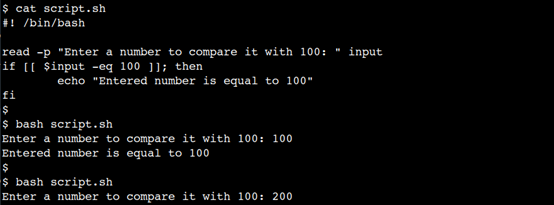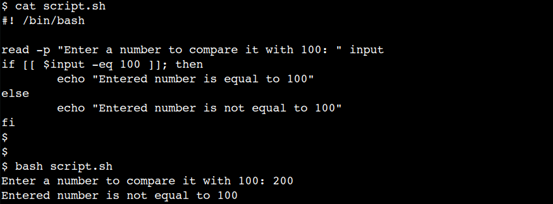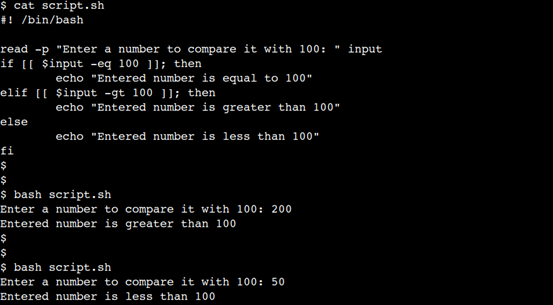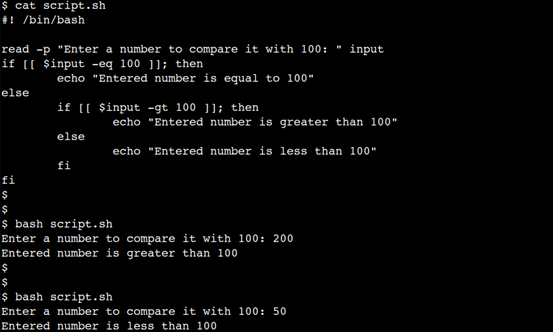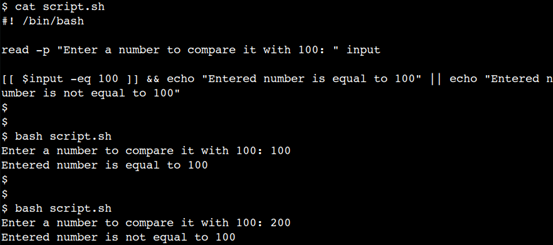In this guide, we will cover how to use conditional statements in the bash script.
Linux users often write scripts to automate repetitive tasks. We can use the conditional statements within the scripts to make them more robust. The conditional statement executes the block of code when certain condition evaluates to true.
There are different forms of conditional statements such as – if, if-else, if-elif-else, and, nested if-else. In this beginner friendly guide, we will understand their usage with practical examples.
Setting up an Example
Let’s demonstrate the use of conditional statements using a simple script. We will write a script that accepts an integer as input and tells whether the provided number is equal to, greater than, or less than a hundred.
We will develop this script step by step. In the beginning, we will just check whether the number is equal to a hundred or not. In the later sections, we will check whether the number is greater or less than a hundred.
if Statement
The general syntax of the if statement is as follows:
if [[ condition ]]; then statement-1 statement-2 statement-3 ... ... statement-N fi
In the above example, statements from the if block gets executed when the condition evaluates to true.
Let’s check whether the number is equal to a hundred or not with the help of the if statement:
#! /bin/bash read -p "Enter a number to compare it with 100: " input if [[ $input -eq 100 ]]; then echo "Entered number is equal to 100" fi
Now, execute the script and enter the value 100 as an input:
$ bash script.sh
Enter a number to compare it with 100: 100 Entered number is equal to 100
In the above example, the script gives the expected output.
Next, run the script again and provide the value 200 as an input:
$ bash script.sh Enter a number to compare it with 100: 200
Here, the script doesn’t give any output. In the next section, we will see how to handle this scenario.
if-else Statement
The general syntax of the if-else statement is as follows:
if [[ condition ]]; then statement-1 statement-2 ... ... statement-N else statement-1 statement-2 ... ... statement-N fi
In this case, statements from the else block get executed when the condition evaluates to false.
Let’s modify the script to display the message when the number is not equal to a hundred. Our modified script looks like this:
#! /bin/bash read -p "Enter a number to compare it with 100: " input if [[ $input -eq 100 ]]; then echo "Entered number is equal to 100" else echo "Entered number is not equal to 100" fi
Now, execute the script and provide the value 200 as an input:
$ bash script.sh Enter a number to compare it with 100: 200 Entered number is not equal to 100
In the above example, the script gives the expected output.
if-elif-else Statement
The general syntax of the if-elif-else statement is as follows:
if [[ condition ]]; then statement-1 statement-2 ... ... statement-N elif [[ condition ]]; then statement-1 statement-2 ... ... statement-N else statement-1 statement-2 ... ... statement-N fi
In this case, statements from the else block get executed when the first two conditions evaluate to false.
Let’s modify the script to identify whether the entered number is greater or less than a hundred. Our modified script looks like this:
#! /bin/bash read -p "Enter a number to compare it with 100: " input if [[ $input -eq 100 ]]; then echo "Entered number is equal to 100" elif [[ $input -gt 100 ]]; then echo "Entered number is greater than 100" else echo "Entered number is less than 100" fi
Now, run the script and provide the value 200 as an input:
$ bash script.sh Enter a number to compare it with 100: 200 Entered number is greater than 100
Here, we can see that the script works as expected.
Next, run the script again and provide the value 50 value as an input:
$ bash script.sh Enter a number to compare it with 100: 50 Entered number is less than 100
In the above output, we can see that the script gives the expected output.
Nested if-else Statement
Bash allows us to use the conditional statement in the nested format. Let’s modify the previous script using the nested if-else statements.
Our modified script looks like this:
$ cat script.sh #! /bin/bash read -p "Enter a number to compare it with 100: " input if [[ $input -eq 100 ]]; then echo "Entered number is equal to 100" else if [[ $input -gt 100 ]]; then echo "Entered number is greater than 100" else echo "Entered number is less than 100" fi fi
In the above example, we used nested if-else statements in the else part.
Now, let’s run the script and verify that it works as expected.
First, provide the value which is greater than a hundred:
$ bash script.sh Enter a number to compare it with 100: 200 Entered number is greater than 100
Next, provide the input value which is less than a hundred:
$ bash script.sh Enter a number to compare it with 100: 50 Entered number is less than 100
Conditional Operators
Bash supports logical AND(&&) and OR(||) operators. We can use these operators as if and else statements.
Let’s check whether the number is equal to a hundred or not using the logical AND(&&) operator:
#! /bin/bash read -p "Enter a number to compare it with 100: " input [[ $input -eq 100 ]] && echo "Entered number is equal to 100"
Now, execute the script and check the output:
$ bash script.sh Enter a number to compare it with 100: 100 Entered number is equal to 100
In a similar way, we can use the logical OR(||) operator as an else statement. Our modified script looks like this:
#! /bin/bash read -p "Enter a number to compare it with 100: " input [[ $input -eq 100 ]] && echo "Entered number is equal to 100" || echo "Entered number is not equal to 100"
Let’s provide the value 200 as an input and observe the result:
$ bash script.sh Enter a number to compare it with 100: 200 Entered number is not equal to 100
Conclusion
In this guide, we discussed how to use various conditional statements in bash. First, we saw the usage of the if statement. Next, we saw how to use an if-else statement. Then we saw how to use the elif and nested if-else statement. Finally, we saw how we can use conditional operators instead of if-else statements.
Read Also : How To Use Variables in Bash Script (Simple Guide)
